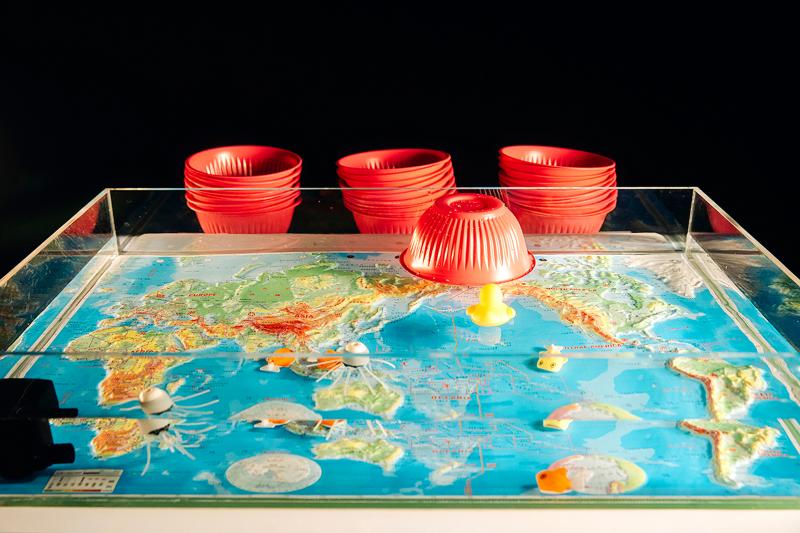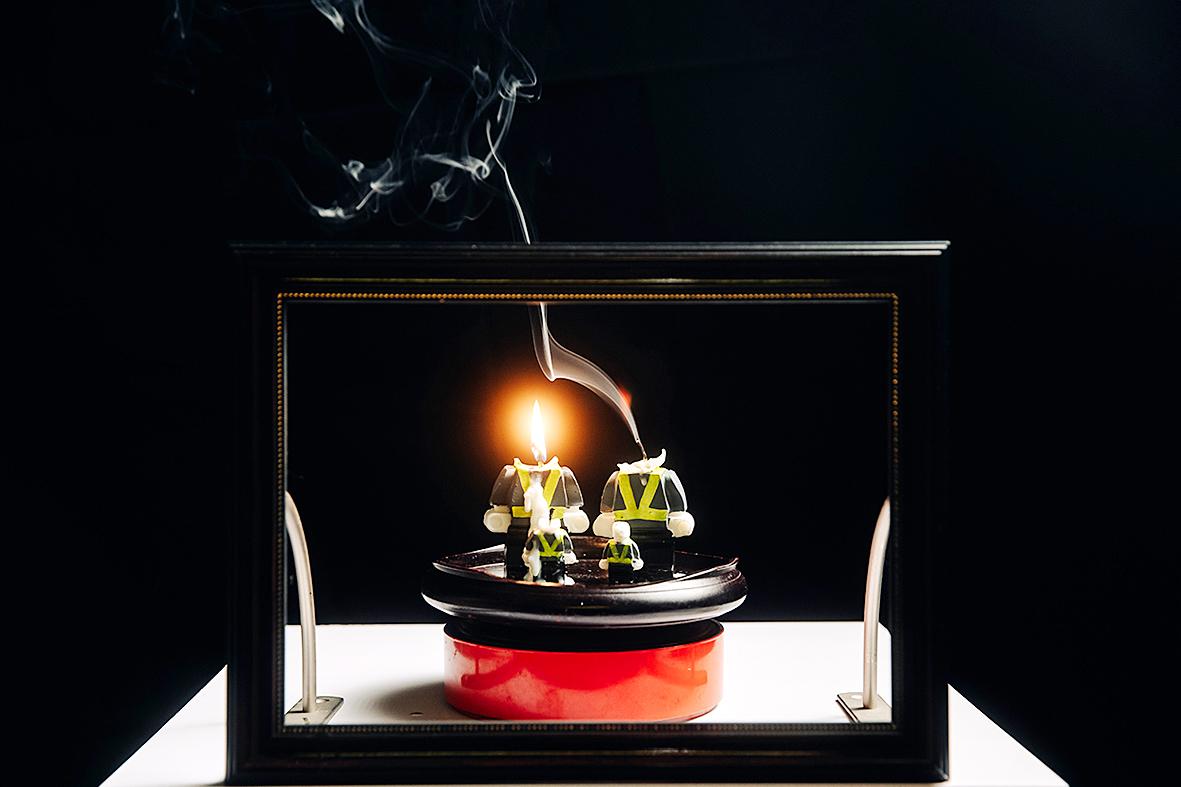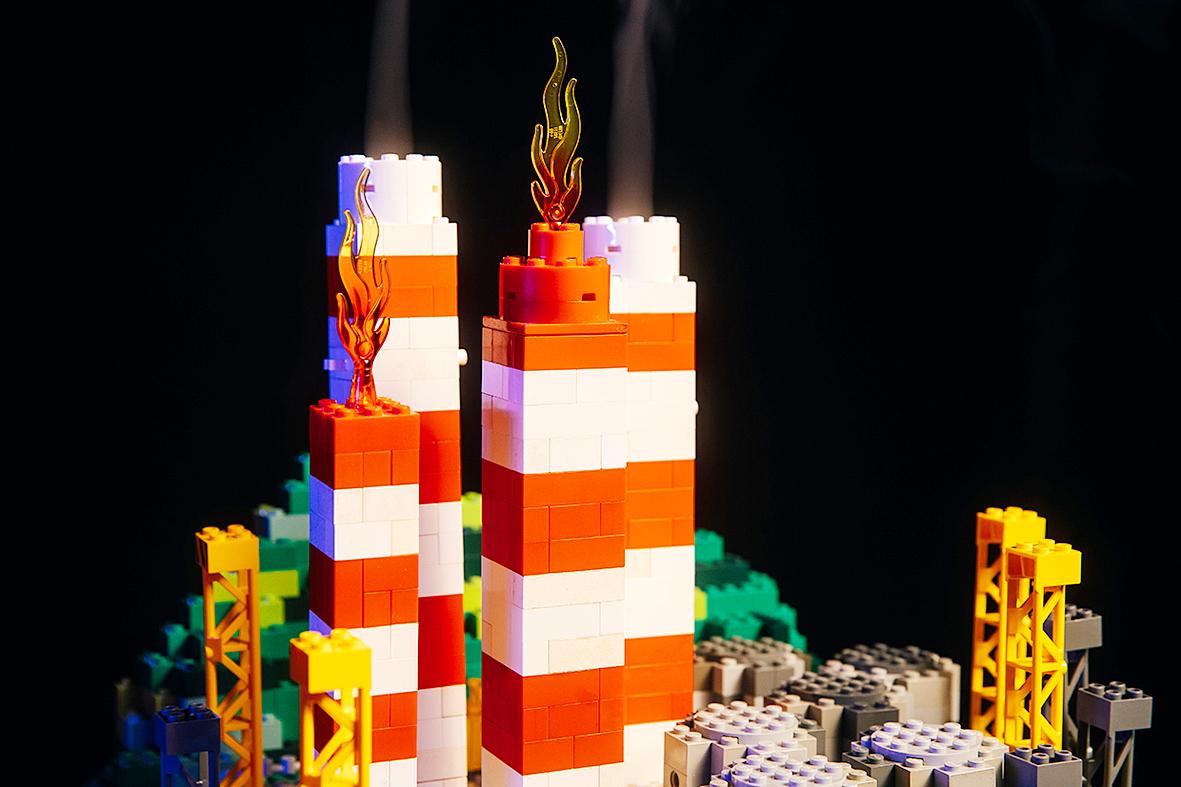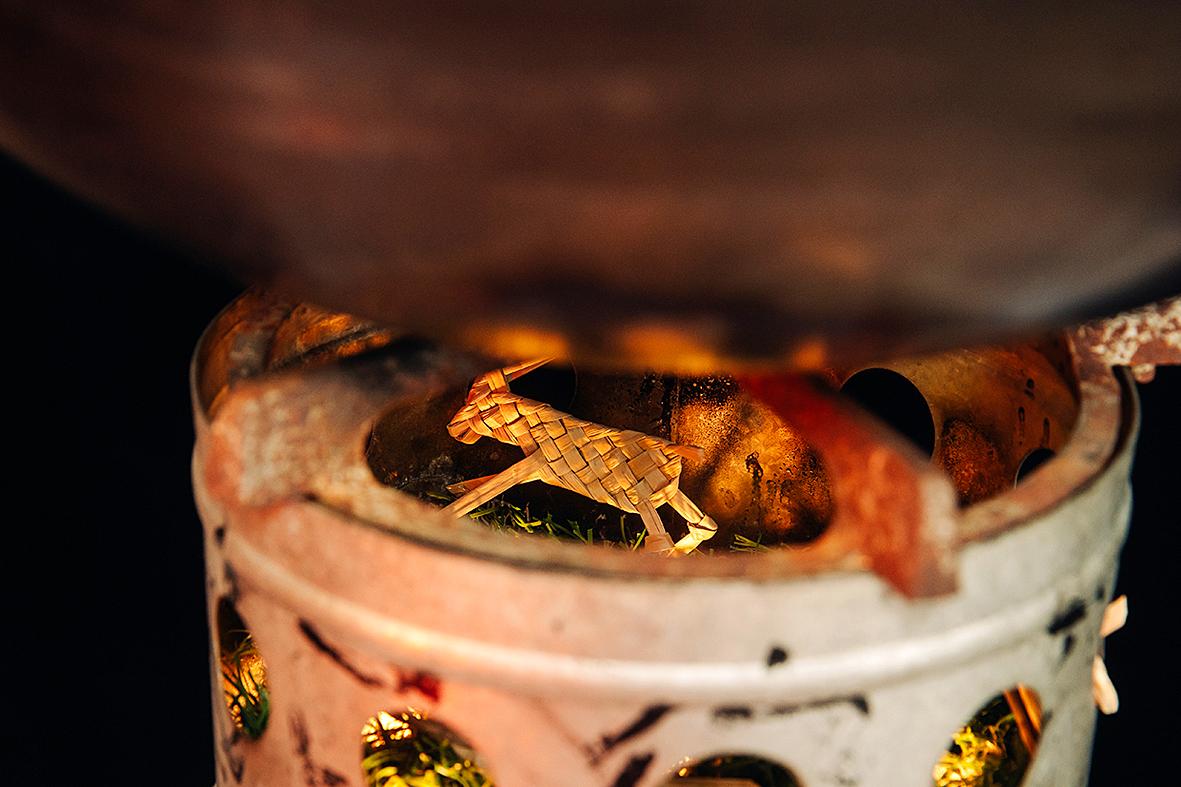In artist Tseng Yen-ting’s (曾彥婷) video Plastic Bowl, a cheery singer narrates a whimsical yet harrowing first-person life story of a plastic bowl: it takes 180 million years for a dead organism to fossilize and become natural gas or oil, 22 days to ship it to a factory, 96 hours to turn it into a disposable bowl, which is used for a mere 16 minutes at a temple banquet.
But that’s not the end.
The bowl breaks down into microplastics that remain in the ocean for thousands of years, and the tiny shards of plastic then watches as humanity leaves for outer space after presumably ruining Earth. The entire process is playfully animated using various found objects.

Photo courtesy of Tseng Yen-ting
“Everybody dies and I’m still on earth! Everybody leaves and I’m still on earth!” sings artist and songwriter Chiang Tao (蔣韜), who has been working with Tseng on petrochemical and plastic pollution-related projects in Taiwan since 2020 through Uncertain Studio (測不準工作室), which they co-founded.
The video shows one of four physical installations that make up Tseng’s latest project, The Collection of Time in the Polymer Age (在聚合世代採集時間), which explores the subjectivity of the scale of time through different topics related to Taiwan’s petrochemical industry.
Tseng became interested in this approach after reading Susan Freinkel’s Plastic: A Toxic Love Story and noticing how plastics have transformed humanity despite only being with us for a fraction of our existence.

Photo courtesy of Tseng Yen-ting
The Collection of Time in the Polymer Age is one of three projects featured by the newly-formed Magnify Art Collective, which invites creators from around the globe to highlight various social and environmental issues and contribute to the creation of new structures and solutions. The current focus is on plastic pollution, and as one of the world’s top petrochemical producers, Taiwan is an important country to focus on.
The project also promotes existing solutions such as zero-packaging stores and delivery giant Food Panda’s reusable container venture and looks at how government policy can be changed.
ART FOR CHANGE

Photo courtesy of Tseng Yen-ting
Specializing in object theater, Tseng says her earlier work was more poetic and focused less on social issues.
“Through performances, I became sensitive to different found objects and materials,” she says.
But after several residencies abroad, she began to explore the development of these materials in human history and how people generally choose to use them.

Photo courtesy of Tseng Yen-ting
“Can there be other choices? Can we choose different ways to live?” she wondered. “Our society no longer has to be one where we take natural resources — timber, camphor, deer hides — and create an industry from it. There are many decisions that lead to the creation of an industry, it’s not a given that it has to be this way.”
She read a lot on the plastic and petrochemical problem, but most of it was focused on the West, prompting her to do more research on the situation in Taiwan.
“I wanted to know how the plastic industry developed in Taiwan and how we became a major exporter of petrochemical products,” she says.
Uncertain Studio’s first project was the board game City of PVC Smokestacks (PVC煙囪之城), which takes players through important events and landmarks in the history of the industry.
Tseng was put in touch with Magnify, which is supported by the Cosmic Foundation, through the academics and activists she met promoting the game, and decided to create a completely new project that could reach more people.
PETROCHEMICAL STORIES
The concept of time was something that kept coming up for Tseng when doing research on the industry. She was astonished by the time it took for fossil fuels to be created versus the time it took to build up a massive single-use plastics industry.
When the Fifth Naphtha Cracker plant announced in 1990 that it would close in 25 years, it seemed like a short time by industry standards, but that’s enough time for an affected resident to see their child grow up and finish grad school.
“The weight of time is completely different, and we wanted to use this as a point of discussion,” Tseng says.
The other videos feature an anthropomorphized Kaohsiung Refinery built from Lego blocks that sighs wistfully, “Like a giant I always accidentally crush those around [me];” an old lady living near a factory who laments the loss of the muntjac deer; and Foreman Lin, whose wax figure melts as his son sings about his hard life that ends in tragedy.
Looking ahead, the Magnify collective will keep adding related projects to it’s roster, while Tseng plans on doing performances at the heavily polluted Dalinpu Community (大林蒲) in Kaohsiung, whose decades-long relocation struggle continues today.
The videos can be viewed at: magnify.art/asia/time.

Oct. 27 to Nov. 2 Over a breakfast of soymilk and fried dough costing less than NT$400, seven officials and engineers agreed on a NT$400 million plan — unaware that it would mark the beginning of Taiwan’s semiconductor empire. It was a cold February morning in 1974. Gathered at the unassuming shop were Economics minister Sun Yun-hsuan (孫運璿), director-general of Transportation and Communications Kao Yu-shu (高玉樹), Industrial Technology Research Institute (ITRI) president Wang Chao-chen (王兆振), Telecommunications Laboratories director Kang Pao-huang (康寶煌), Executive Yuan secretary-general Fei Hua (費驊), director-general of Telecommunications Fang Hsien-chi (方賢齊) and Radio Corporation of America (RCA) Laboratories director Pan

The classic warmth of a good old-fashioned izakaya beckons you in, all cozy nooks and dark wood finishes, as tables order a third round and waiters sling tapas-sized bites and assorted — sometimes unidentifiable — skewered meats. But there’s a romantic hush about this Ximending (西門町) hotspot, with cocktails savored, plating elegant and never rushed and daters and diners lit by candlelight and chandelier. Each chair is mismatched and the assorted tables appear to be the fanciest picks from a nearby flea market. A naked sewing mannequin stands in a dimly lit corner, adorned with antique mirrors and draped foliage
The consensus on the Chinese Nationalist Party (KMT) chair race is that Cheng Li-wun (鄭麗文) ran a populist, ideological back-to-basics campaign and soundly defeated former Taipei mayor Hau Lung-bin (郝龍斌), the candidate backed by the big institutional players. Cheng tapped into a wave of popular enthusiasm within the KMT, while the institutional players’ get-out-the-vote abilities fell flat, suggesting their power has weakened significantly. Yet, a closer look at the race paints a more complicated picture, raising questions about some analysts’ conclusions, including my own. TURNOUT Here is a surprising statistic: Turnout was 130,678, or 39.46 percent of the 331,145 eligible party

The election of Cheng Li-wun (鄭麗文) as chair of the Chinese Nationalist Party (KMT) marked a triumphant return of pride in the “Chinese” in the party name. Cheng wants Taiwanese to be proud to call themselves Chinese again. The unambiguous winner was a return to the KMT ideology that formed in the early 2000s under then chairman Lien Chan (連戰) and president Ma Ying-jeou (馬英九) put into practice as far as he could, until ultimately thwarted by hundreds of thousands of protestors thronging the streets in what became known as the Sunflower movement in 2014. Cheng is an unambiguous Chinese ethnonationalist,